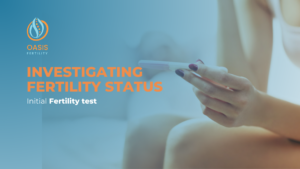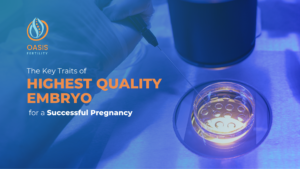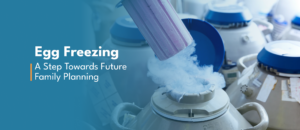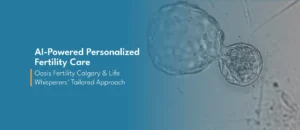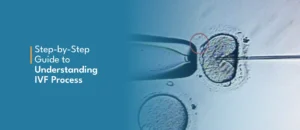Step-by-Step Guide to Understanding the IVF Process

In Vitro Fertilization (IVF) offers a ray of hope for those couples and single individuals seeking parenthood.
But what exactly is IVF? Why do people choose it? And how does the IVF process work?
We unravel the mysteries and complexities behind IVF pregnancy and shed light on how we at Oasis Fertility Centre help individuals from all communities in their journey to parenthood.
This step-by-step guide will provide you with all the information you need to understand and navigate through the IVF process successfully.
What is In Vitro Fertilization (IVF)?
In Vitro Fertilization, also known as IVF pregnancy, is a fertility treatment that has revolutionized the way couples and single individuals can achieve their dream of having a baby. This assisted reproductive technology involves combining eggs and sperm in a laboratory setting rather than within the fallopian tubes.
The process begins by stimulating the ovaries to produce multiple mature eggs through hormonal medications. These medications are administered through injections and are closely monitored by fertility specialists. Once the eggs reach maturity, they are retrieved during a minor surgical procedure under anesthesia.
By understanding what IVF entails, individuals and couples can make informed decisions about pursuing this remarkable fertility treatment option. It’s an intricate process that requires expertise from dedicated professionals who understand each patient’s unique situation.
How does IVF pregnancy help?
There are a multitude of reasons why individuals and couples turn to in vitro fertilization as a solution for their fertility struggles.
For some, it may be the result of medical conditions such as blocked fallopian tubes or low sperm count. Others may have tried other fertility treatments without success and see IVF as their best chance at achieving pregnancy. Additionally, age can play a role, with women over 35 often facing decreased fertility and considering IVF as an option.
Emotional factors also come into play. The desire to have a child is incredibly strong for many individuals and couples, and IVF offers hope where there was once despair. It provides an opportunity to fulfil the dream of parenthood when conventional methods have failed.
IVF also allows for genetic screening of embryos, which can prevent certain genetic disorders from being passed on to future generations.
The decision to pursue IVF is deeply personal and varies from person to person. It represents a ray of hope amidst challenging circumstances, offering the possibility of creating a family that might otherwise not be possible.
The step-by-step IVF process
The IVF process is a complex but hopeful journey that many individuals and couples embark upon to achieve their dream of starting or expanding their family. Understanding the IVF step-by-step process can help demystify this procedure and alleviate any anxiety you may have.
1. Initial Consultation and Evaluation
When considering the IVF process, the first step is typically an evaluation and initial consultation with a fertility specialist. This crucial step allows both you and your doctor to gather important information about your medical history, lifestyle factors, and any previous attempts at conception.
During this consultation, your doctor will review your results of the initial investigations done recently within the past 6 months, ask questions about your menstrual cycle, previous pregnancies (if any), and any underlying health conditions or genetic disorders that may affect fertility. You will also be able to discuss your goals and expectations for IVF treatment.
In addition to reviewing medical history, a physical examination may be conducted to assess reproductive organs such as the uterus and ovaries. You may also have blood tests ordered to evaluate hormone levels and check for potential infections or diseases.
2. Ovarian Stimulation
Ovarian stimulation is a pivotal IVF step aimed at enhancing egg production. Fertility medications, tailored to individual needs, are typically administered via daily subcutaneous or intramuscular injections for 8-14 days. Regular monitoring appointments track follicle development, allowing for precise medication dosage adjustments based on the body’s response.
The aim is to produce multiple mature eggs, increasing the likelihood of successful fertilization and embryo selection. While hormone stimulation may cause temporary discomfort, such as pelvic bloating or tenderness, it is well-managed with the support of your fertility team, playing a vital role in optimizing IVF success by maximizing egg production for retrieval.
4. Egg Retrieval
After completing the hormone stimulation phase, the crucial step of egg retrieval begins in the IVF process. This procedure is typically conducted under sedation or anesthesia to ensure your comfort. Using ultrasound guidance and a thin needle, the doctor collects eggs from each ovary, and rest assured, it’s not a painful process.
Embryologists carefully examine the retrieved eggs to assess their quality and maturity. The number of eggs collected may vary depending on individual circumstances, but even one healthy egg holds the potential for a successful pregnancy. Once collected, the eggs are ready for the next stage in the IVF process: fertilization and embryo development in a laboratory setting.
5. Fertilization and Embryo Development
Fertilization and embryo development mark a critical stage in the IVF process, where the science of creating new life takes centre stage.
In the laboratory, the retrieved eggs are meticulously examined under a microscope before fertilization. Two common methods are employed: conventional IVF and intracytoplasmic sperm injection (ICSI). Conventional IVF places many healthy sperm around each egg in a culture dish, allowing natural penetration and fertilization. ICSI involves injecting a single sperm directly into an egg using microscopic techniques chosen based on factors like sperm quality or fertility history.
After successful fertilization, embryos develop over several days in an incubator that replicates conditions inside the body of the individual. Skilled embryologists closely monitor their growth during this period.
Typically, after three to five days post-fertilization, when embryos reach the blastocyst stage with approximately 70-100 cells, one or more are chosen for transfer back into the uterus. Any remaining healthy embryos can be cryopreserved (frozen) for future use, with advancements in freezing technology ensuring high success rates comparable to fresh embryo transfers.
6. Embryo Transfer
Embryo transfer is a pivotal IVF step, representing months of preparation. Once embryos have matured in the lab, they can transfer into the uterus. The doctor will discuss the number of embryos to transfer based on your age and embryo quality, aiming for success while avoiding multiple pregnancies.
The procedure is typically quick and painless, not requiring anesthesia or sedation. Using ultrasound guidance, a thin catheter is inserted through the cervix into the uterus, where the embryos are gently released into the ideal location. A brief rest is advised, and any mild cramping or spotting typically subsides quickly.
Consult Oasis Fertility Centre for expert care in IVF pregnancy
To embark on the journey of IVF is to take a courageous step towards fulfilling your dreams of parenthood. While the process may seem overwhelming initially, Dr. Imran Pirwany at Oasis Fertility Centre can understand each step and help alleviate some of the uncertainties and fears that may arise.
From the initial consultation at Oasis Fertility Centre and evaluation to the embryo transfer, our experts are committed to guiding you through your path of IVF pregnancy.


